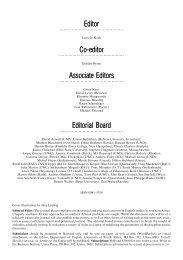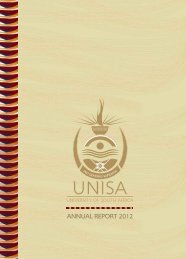Download the Annual report 2011 - Unisa
Download the Annual report 2011 - Unisa
Download the Annual report 2011 - Unisa
Create successful ePaper yourself
Turn your PDF publications into a flip-book with our unique Google optimized e-Paper software.
UNISA ANNUAL REPORT <strong>2011</strong><br />
pre-tax discount rate that reflects current market assessments of <strong>the</strong> time value of money and <strong>the</strong> risks specific<br />
to <strong>the</strong> asset. For an asset that does not generate largely independent cash inflows, <strong>the</strong> recoverable amount is<br />
determined for <strong>the</strong> cash-generating unit to which <strong>the</strong> asset belongs.<br />
2.8.2 Reversals of impairment<br />
In respect of o<strong>the</strong>r non-financial assets, impairment losses recognised in prior periods are assessed at each<br />
<strong>report</strong>ing date for any indications that <strong>the</strong> loss has decreased or no longer exists.<br />
In respect of non-financial assets, an impairment loss is reversed if <strong>the</strong>re has been a change in <strong>the</strong> estimates<br />
used to determine <strong>the</strong> recoverable amount. An impairment loss is reversed only to <strong>the</strong> extent that <strong>the</strong> asset’s<br />
carrying amount does not exceed <strong>the</strong> carrying amount that would have been determined, net of depreciation<br />
or amortisation, if no impairment loss had been recognised.<br />
An impairment loss in respect of receivables carried at amortised cost is reversed if <strong>the</strong> subsequent increase in<br />
recoverable amount can be related objectively to an event occurring after <strong>the</strong> impairment loss was recognised.<br />
The reversal of impairment losses on <strong>the</strong>se financial assets is recognised in profit or loss.<br />
2.9 FOREIGN CURRENCIES<br />
The foreign currency gain or loss on monetary items is <strong>the</strong> difference between amortised cost in <strong>the</strong> functional<br />
currency at <strong>the</strong> beginning of <strong>the</strong> period, adjusted for effective interest and payments during <strong>the</strong> period, and <strong>the</strong><br />
amortised cost in foreign currency translated at <strong>the</strong> exchange rate at <strong>the</strong> end of <strong>the</strong> period.<br />
Foreign currency transactions are translated to <strong>the</strong> University’s functional currency at <strong>the</strong> exchange rates prevailing<br />
at <strong>the</strong> date of <strong>the</strong> transactions. Monetary assets and liabilities denominated in foreign currencies at <strong>the</strong><br />
<strong>report</strong>ing date are translated to <strong>the</strong> functional currency at rates of exchange ruling at <strong>the</strong> end of <strong>the</strong> financial<br />
year.<br />
It is not <strong>the</strong> policy of <strong>the</strong> University to take out forward exchange contracts on foreign currency transactions<br />
entered into.<br />
2.10 LEASES<br />
2.10.1 Finance leases<br />
Leases of property, plant and equipment where <strong>the</strong> University obtains substantially all <strong>the</strong> risks and rewards<br />
of ownership are classified as finance leases. Finance leases are capitalised. All o<strong>the</strong>r leases are classified as<br />
operating leases. The classification is based on <strong>the</strong> substance and financial reality of <strong>the</strong> whole transaction<br />
ra<strong>the</strong>r than <strong>the</strong> legal form. Leases of land and buildings are analysed separately to determine whe<strong>the</strong>r each<br />
component is an operating or finance lease.<br />
At <strong>the</strong> commencement of <strong>the</strong> lease term, finance leases are recognised as assets and liabilities in <strong>the</strong> statement<br />
of financial position at an amount equal to <strong>the</strong> fair value of <strong>the</strong> leased asset or, if lower, <strong>the</strong> present value of <strong>the</strong><br />
minimum lease payments. Any direct costs incurred in negotiating or arranging a lease is added to <strong>the</strong> cost<br />
of <strong>the</strong> asset. The discount rate used in calculating <strong>the</strong> present value of minimum lease payments is <strong>the</strong> rate<br />
implicit in <strong>the</strong> lease.<br />
Capitalised leased assets are accounted for as property, plant and equipment. They are depreciated using <strong>the</strong><br />
straight-line basis at rates considered appropriate to write off <strong>the</strong> depreciable amount over <strong>the</strong> estimated useful<br />
lives. Where it is not certain that an asset will be taken over by <strong>the</strong> University at <strong>the</strong> end of <strong>the</strong> lease, <strong>the</strong> asset<br />
is depreciated over <strong>the</strong> shorter of <strong>the</strong> lease period and <strong>the</strong> estimated useful life of <strong>the</strong> asset.<br />
Finance lease payments are allocated between <strong>the</strong> lease finance cost and <strong>the</strong> capital repayment using <strong>the</strong> effective<br />
interest method. Lease finance costs are charged to operating costs as <strong>the</strong>y become due.<br />
| 84 |

















